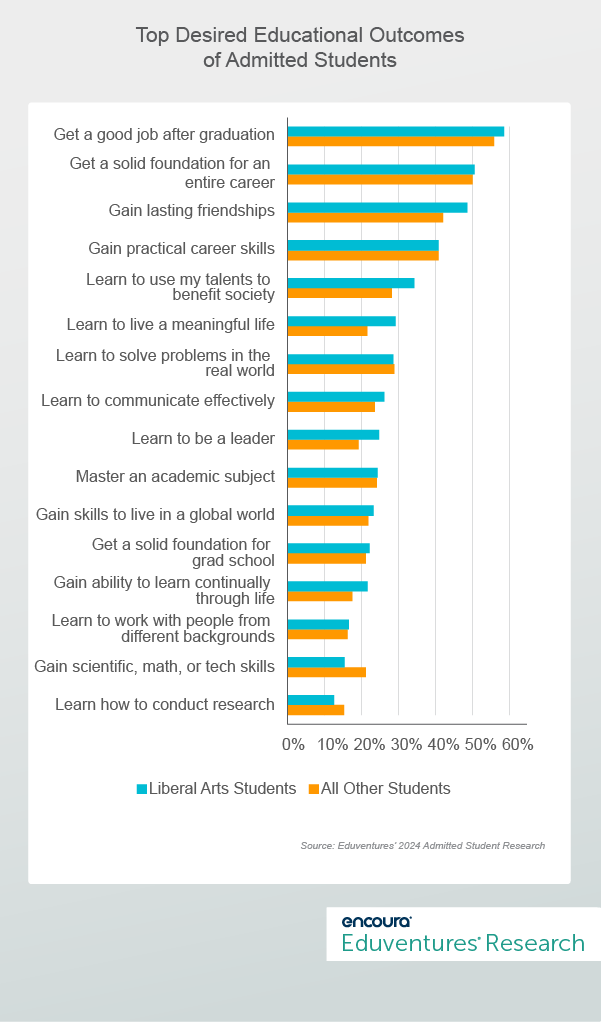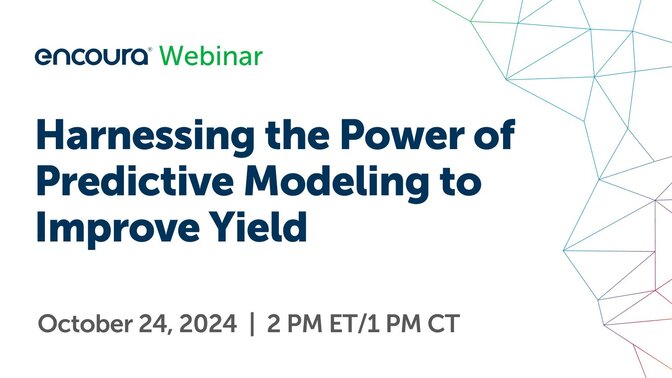It is not an easy time for less selective liberal arts institutions. Many of the colleges that have announced closures or mergers in recent years are small liberal arts schools with histories of declining enrollment. With the demographic cliff at the gate, more are likely to follow.
In our recent Admitted Student Research™, only 7% of students indicated they chose to enroll in a liberal arts institution. The appetite for liberal arts education is small, and student populations are shrinking. How can these institutions—and humanities departments in general—stay relevant in a changing market?
Wanted: Liberal Arts Students
While many students continue to enroll in liberal arts institutions, the lure of a broad education that aims to help develop well-rounded, engaged citizens has diminished. So, who are the students still drawn to liberal arts institutions?
Table 1 shows some key characteristics of students who enrolled in liberal arts institutions (defined as institutions that identify a liberal arts focus in their mission and identity statements) and how they compare to the students who enrolled in other types of institutions.
Key Characteristics of Liberal Arts Students vs. All Others
|
Liberal Arts Students |
All Other Students |
|
|
White |
53% |
40% |
|
Female |
66% |
58% |
|
First-generation student |
28% |
30% |
|
Exploration and Meaning Mindset |
13% |
8% |
|
Interest in Humanities and Social Sciences |
14% |
10% |
|
Interest in STEM |
46% |
55% |
Table 1.
As Table 1 shows, students at liberal arts institutions are more often White and female than students who enroll at other types of institutions. They are also more likely to fall into the Exploration & Meaning Mindset, characteristic of students with a broad range of academic interests—including the humanities—who want to make an impact on the world.
Indeed, students at liberal arts institutions show a greater interest in the humanities and social sciences and less interest in STEM fields compared to other students—but not by a large margin. In fact, nearly half of liberal arts students plan to major in a STEM field. And more than 85% of liberal arts students fall into a Mindset other than Exploration & Meaning.
This means that while the “typical” liberal arts student is still out there, liberal arts institutions now serve a broad range of students. And they must continue to do so. The “typical” liberal arts student is a rare find. In contrast, the student of the future is more diverse, more sensitive to the cost of college, and more likely to question the value of a well-rounded education.
Unless…
Reframing Liberal Arts
Perhaps reframing the conversation about liberal arts could help make this pedagogical approach more palatable to the broader masses. Case in point, Figure 1 shows that students at liberal arts institutions differ from other types of students on some, but not all, desirability perceptions of liberal arts outcomes.

Figure 1.
Figure 1 shows some key differences between students who enroll at liberal arts schools vs. other types of schools. Liberal arts students more often hope to make lifelong friendships. They are also more eager to benefit society, seek a meaningful life, and develop leadership skills than other students.
Notably, these values are often positive side effects—or secondary goals—of a liberal arts education; they are not the core goals. A liberal arts education traditionally seeks to foster critical thinking, communication, and problem-solving skills, and aims to form engaged citizens with a desire for lifelong learning.
While a slim margin of liberal arts students indeed shows a greater interest in lifelong learning (22% vs. 18% other students), it is not a key outcome for either type of student. And, both types of students show a similar level of interest in learning to solve problems in the real world and learning effective communication.
In summary, the outcomes of a liberal arts education are equally attractive to students who enroll in liberal arts colleges and those who enroll elsewhere.
More importantly, students at liberal arts institutions want a job and a career just as much, if not more so, than other students. Liberal arts students likely see how their chosen college paths will lead to their goals. But many more students, 93% to be exact, do not make this connection and choose institutions without a liberal arts focus.
The Bottom Line
A liberal arts education is an increasingly tough sell to students in the current enrollment pipeline. Even students who enroll in liberal arts institutions show only moderate interest in the purported benefits of this educational approach. The appeal seems to be less about the core liberal arts outcomes, but rather peripheral outcomes like making personal connections, meaning, and impact.
The broader student market is driven by economic realities and a need for return-on-investment—priorities that liberal arts institutions and humanities programs more generally must address as well. They must do two things to connect the dots for students and families:
- Show how a liberal arts education contributes to a meaningful career. Thriving in long-term careers requires more than just job-specific skills. Liberal arts institutions know that their educations impart essential skills valued by employers, though students and families may not always recognize this. Give examples of the various career paths achievable with a liberal arts degree.
- Create proof that a liberal arts education leads to jobs and careers. Messaging alone will not be enough to shift the needle and let broader student segments buy into the benefits of a liberal arts education. Students and their families will need to see—not just hear—that a liberal arts education can lead to successful career outcomes. Alumni outcomes, graduate salaries, and other metrics will tell a stronger story than the promise that liberal arts skills are relevant.


